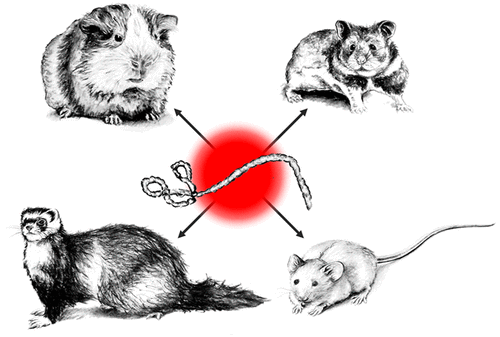当前位置:
X-MOL 学术
›
ACS Infect. Dis.
›
论文详情
Our official English website, www.x-mol.net, welcomes your
feedback! (Note: you will need to create a separate account there.)
Small Animal Models for Evaluating Filovirus Countermeasures
ACS Infectious Diseases ( IF 4.0 ) Pub Date : 2018-02-19 00:00:00 , DOI: 10.1021/acsinfecdis.7b00266 Logan Banadyga 1, 2 , Gary Wong 1, 2, 3 , Xiangguo Qiu 1, 2
ACS Infectious Diseases ( IF 4.0 ) Pub Date : 2018-02-19 00:00:00 , DOI: 10.1021/acsinfecdis.7b00266 Logan Banadyga 1, 2 , Gary Wong 1, 2, 3 , Xiangguo Qiu 1, 2
Affiliation

|
The development of novel therapeutics and vaccines to treat or prevent disease caused by filoviruses, such as Ebola and Marburg viruses, depends on the availability of animal models that faithfully recapitulate clinical hallmarks of disease as it is observed in humans. In particular, small animal models (such as mice and guinea pigs) are historically and frequently used for the primary evaluation of antiviral countermeasures, prior to testing in nonhuman primates, which represent the gold-standard filovirus animal model. In the past several years, however, the filovirus field has witnessed the continued refinement of the mouse and guinea pig models of disease, as well as the introduction of the hamster and ferret models. We now have small animal models for most human-pathogenic filoviruses, many of which are susceptible to wild type virus and demonstrate key features of disease, including robust virus replication, coagulopathy, and immune system dysfunction. Although none of these small animal model systems perfectly recapitulates Ebola virus disease or Marburg virus disease on its own, collectively they offer a nearly complete set of tools in which to carry out the preclinical development of novel antiviral drugs.
中文翻译:

小动物模型用于评估丝状病毒的对策
用于治疗或预防由线状病毒(例如埃博拉病毒和马尔堡病毒)引起的疾病的新型疗法和疫苗的开发,取决于动物模型的可用性,这些模型能够忠实地概括人类在疾病中的临床特征。特别是,小动物模型(例如小鼠和豚鼠)在非人类灵长类动物中进行测试之前,通常被用于抗病毒对策的初步评估,这代表了金标准丝状病毒动物模型。然而,在过去的几年中,丝状病毒领域见证了小鼠和豚鼠疾病模型的不断完善,以及仓鼠和雪貂模型的引入。现在,我们有了大多数人类致病性丝状病毒的小型动物模型,其中许多病毒易受野生型病毒感染,并显示出疾病的关键特征,包括强大的病毒复制,凝血病和免疫系统功能障碍。尽管这些小型动物模型系统都不能单独完美地概括埃博拉病毒病或马尔堡病毒病,但它们共同提供了将近一套完整的工具来进行新型抗病毒药物的临床前开发。
更新日期:2018-02-19
中文翻译:

小动物模型用于评估丝状病毒的对策
用于治疗或预防由线状病毒(例如埃博拉病毒和马尔堡病毒)引起的疾病的新型疗法和疫苗的开发,取决于动物模型的可用性,这些模型能够忠实地概括人类在疾病中的临床特征。特别是,小动物模型(例如小鼠和豚鼠)在非人类灵长类动物中进行测试之前,通常被用于抗病毒对策的初步评估,这代表了金标准丝状病毒动物模型。然而,在过去的几年中,丝状病毒领域见证了小鼠和豚鼠疾病模型的不断完善,以及仓鼠和雪貂模型的引入。现在,我们有了大多数人类致病性丝状病毒的小型动物模型,其中许多病毒易受野生型病毒感染,并显示出疾病的关键特征,包括强大的病毒复制,凝血病和免疫系统功能障碍。尽管这些小型动物模型系统都不能单独完美地概括埃博拉病毒病或马尔堡病毒病,但它们共同提供了将近一套完整的工具来进行新型抗病毒药物的临床前开发。











































 京公网安备 11010802027423号
京公网安备 11010802027423号